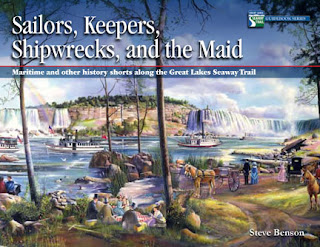
As Nik Wallenda prepares to walk over Niagara Falls, the newest book in the Great Lakes Seaway Trail Guidebook Series – Sailors, Keepers, Shipwrecks, and The Maid – tells the stories of the Falls’ first tightrope walkers and other daredevils, the famous, and fascinating everyday people who have lived, worked, played and traveled along the Lake Erie, Niagara River, Lake Ontario and St. Lawrence River shorelines in New York and Pennsylvania.
Readers will discover interesting details about American Presidents, pirates, pioneers, chefs, lighthouse keepers, artists, and adventurers in the collection of vignettes enhanced by historic photographs, art, illustrations and maps.
The Maid in the new book’s title is the Maid of the Mist tour boat, a Niagara Falls tradition since 1846 and co-sponsor of the book project.
The guide’s introduction encourages driving the full 518 miles of the National Scenic Byway and stopping at a series of Great Lakes Seaway Trail “Outdoor Storyteller” signs to learn more facts about local architecture, agriculture, maritime, military and natural history.
The new book is written by Steve Benson and published by the nonprofit tourism promoter Seaway Trail, Inc., Sackets Harbor, NY. Benson is also co-author of Great Lakes Seaway Trail’s French and Indian War guidebook Waterways of Way: The Struggle for Empire 1754-1763.
Learn more about the Great Lakes Seaway Trail series of travel guides voted “Best of the Byways” by the American Recreation Coalition online at www.seawaytrail.com or call 315-646-1000 x200.
Lake Erie region stories in Sailors, Keepers, Shipwrecks, and the Maid include: tales of fish wars and Lake Erie’s fury, the Erie Triangle, Dan Rice and Daniel Dobbins, War of 1812 combatants, grape growers, Celeron’s many legacies, the Dunkirk Lighthouse and notable shipwrecks.
Buffalo/Niagara Falls region stories include: Frank Lloyd Wright’s architectural masterpieces, a tale of pistols at 12 paces, shipwrecks and pirates, Underground Railroad heroes, the ghost of the French Castle, and the “Cat-of-the-Mist.”
Rochester/Central Lake Ontario region stories include: War of 1812 heroine Bathshua Sheffield Brown (her ancestors operate Brown’s Berry Patch, Waterport, NY)- Sam Patch, the Yankee Leaper- photography pioneer George Eastman, the Underground Railroad on Sodus Bay.
Eastern Lake Ontario region stories include: Harriet Tubman and other Underground Railroad heroes, “The Big Cheese,” the War of 1812 Battle of Big Sandy, a female Commandant at Sackets Harbor, a tale of two wrecks, and The Whittlesey Woman.
Thousand Islands/St. Lawrence River region stories include: skiffs, steamships, and yachts- pirate Bill Johnston- a Maple Island murder mystery- two castles- artist Frederic Remington, Fort de La Presentation, and the 1760 Battle of the 1000 Islands.








